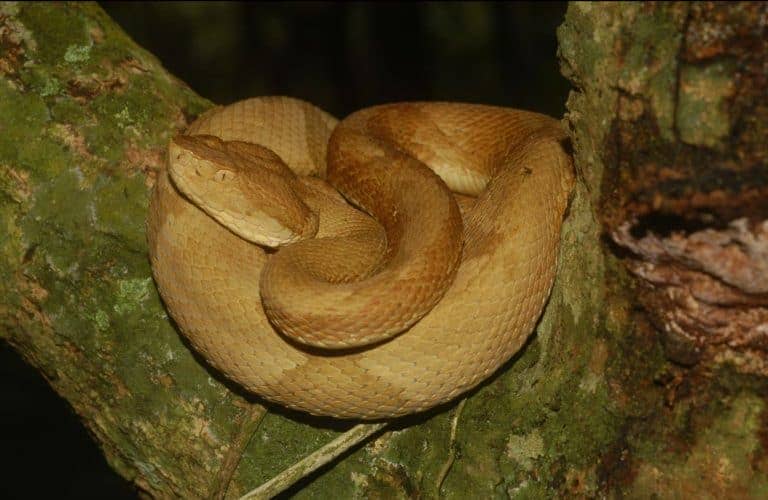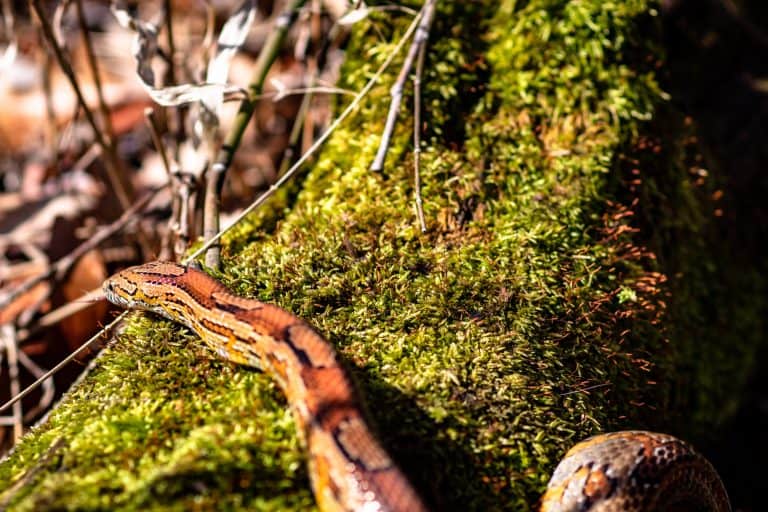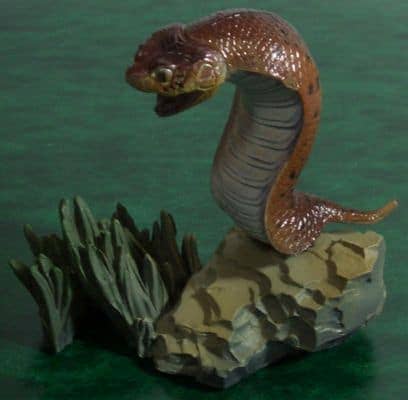Why the Golden Lancehead Is So Fascinating
If there’s one snake that truly earns the title “killer beauty,” it’s the Golden Lancehead Viper. Strikingly golden, incredibly venomous, and found nowhere else on Earth but a single forbidden island, this serpent is wrapped in both danger and mystery.
Quick Snapshot of the Species
Scientific Name: Bothrops insularis
Habitat: Snake Island (Ilha da Queimada Grande), Brazil
Venom: Hemotoxic and extremely lethal
Length: 28 to 46 inches
Population: Estimated 2,000 – 4,000
Classification and Taxonomy
Scientific Name and Family
The Golden Lancehead belongs to the Viperidae family and is classified scientifically as Bothrops insularis. It shares its roots with a deadly group known as pit vipers, known for their heat-sensing abilities.
Relationship to Other Pit Vipers
It’s closely related to the common lancehead (Bothrops jararaca), but isolation over thousands of years has made it genetically and physically distinct.
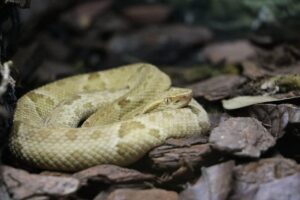
Physical Characteristics
Distinctive Appearance
Its golden-tan color isn’t just pretty—it’s camouflage, perfectly suited for blending into the dry, leaf-littered forest floor of its island home.
Size and Coloration
The snake averages 2 to 4 feet long, with a slender body and a lance-shaped head (hence the name). Unlike some of its duller cousins, its shimmering golden hues make it stand out.
Venom Glands and Fangs
Equipped with long, rotating fangs, it injects venom deep into its prey. The venom is three to five times more potent than that of mainland relatives.
Habitat and Geographic Range
Where Is the Golden Lancehead Found?
You won’t find this snake roaming the Amazon or slithering through your backyard. It only lives on Ilha da Queimada Grande, a tiny island off the coast of São Paulo, Brazil.
Life on Ilha da Queimada Grande (Snake Island)
This island is just 106 acres, yet it’s one of the deadliest places on Earth thanks to these vipers. It’s so dangerous, Brazil banned public access.
Why This Island Is So Unique
With no natural predators and plenty of birds to prey on, the Golden Lancehead thrived. But isolation means its population is fragile.
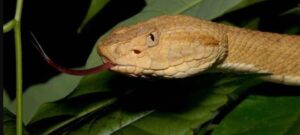
Behavior and Lifestyle
Hunting and Diet
The Golden Lancehead is an ambush predator, waiting patiently before striking with lightning speed. It mainly eats migratory birds that land on the island.
Mating Habits
Mating season is during the warmer months. Males engage in “combat dances” to win females. Females give birth to live young rather than laying eggs.
Activity Patterns (Day vs Night)
Unlike many snakes, it’s partially diurnal—active during the day and night. This helps it maximize hunting opportunities.
Venom and Danger to Humans
What Makes Its Venom So Potent?
Its venom is hemotoxic, meaning it destroys blood cells and causes internal bleeding. It can melt flesh and lead to organ failure.
Symptoms of a Bite
Though no confirmed bites have occurred in the wild, symptoms would include:
-
Swelling and pain
-
Nausea and vomiting
-
Hemorrhaging
-
Kidney failure
-
Death if untreated
Is It Really That Dangerous?
Yes—lab studies show its venom can kill human tissue rapidly. It’s considered one of the most venomous snakes in the world.
Conservation Status
IUCN Red List Status
The Golden Lancehead is listed as Critically Endangered by the IUCN.
Main Threats
-
Habitat loss
-
Illegal wildlife trade
-
Inbreeding due to isolation
Conservation Efforts
Brazil’s government has:
-
Banned access to the island
-
Imposed strict wildlife protection laws
-
Supported scientific research and captive breeding programs
Myths and Legends
Popular Myths About the Golden Lancehead
Some say the island is so overrun, you’ll see a snake every 6 feet. While exaggerated, it feeds into the snake’s mythos.
Truth vs Fiction
Yes, it’s deadly. No, it won’t chase you through the jungle like in a horror movie. It prefers staying hidden unless provoked.
Human Interaction
Why People Are Forbidden From the Island
The Brazilian Navy only allows scientists to visit—and only with permission and medical supervision. The risk is simply too high.
Medical Research and the Golden Lancehead
Its venom contains enzymes that might help treat heart disease and blood clots. Scientists are studying it for pharmaceutical breakthroughs.
Unique Adaptations
Evolution of the Golden Lancehead
Separated from the mainland for over 11,000 years, it evolved:
-
More potent venom (to kill birds quickly)
-
Brighter color (for camouflage)
How Isolation Shaped the Species
With fewer prey options, it became a specialist. This also makes it highly vulnerable to environmental change.
Comparison With Other Lanceheads
Golden Lancehead vs Common Lancehead
| Feature | Golden Lancehead | Common Lancehead |
|---|---|---|
| Venom Potency | Extremely high | Moderate |
| Location | Only Snake Island | Mainland South America |
| Size | Up to 46 inches | Up to 63 inches |
| Appearance | Golden-tan | Darker with patterns |
Key Differences in Venom and Habitat
The Golden Lancehead has evolved for efficiency—its venom acts fast, and it doesn’t waste energy chasing prey. The Common Lancehead is more generalist.
Can You Own One as a Pet?
Legal Restrictions
Absolutely not. It’s illegal to own or export this snake.
Ethical and Practical Concerns
Even if it were legal, keeping a deadly snake in captivity is reckless and dangerous. These snakes belong in their native habitat.
Interesting Facts
Rare Sightings
Because the island is off-limits, almost no one has seen this snake in person. It’s like the unicorn of vipers.
Fun and Bizarre Trivia
-
It can go months without eating
-
One of the few snakes whose population is measured in hundreds per hectare
-
It inspired horror films like “Snake Island”
Conclusion
The Golden Lancehead Viper is one of nature’s most incredible creations. With deadly venom, stunning looks, and a mysterious island home, it’s no wonder it captivates scientists and thrill-seekers alike. But it’s more than a scary snake—it’s a symbol of evolution, a biological treasure, and a species in need of protection. Whether you’re a herpetology nerd or just someone who loves a good mystery, the Golden Lancehead deserves your attention—and respect.
FAQs
Are there other snakes like the Golden Lancehead?
Yes, it’s related to the Bothrops genus, including the Common Lancehead and Fer-de-lance, but none have quite the same venom potency or island isolation.
How many are left in the wild?
Estimates suggest there are between 2,000 and 4,000, but exact numbers are hard to determine due to limited access.
Can antivenom treat a bite from this species?
There’s no specific antivenom for the Golden Lancehead, but treatments used for related species may offer some effectiveness.
Why is it only found on Snake Island?
Thousands of years ago, rising sea levels isolated this population from the mainland. Over time, it evolved separately.
Has anyone ever survived a bite?
No recorded bites have occurred in the wild due to limited human contact. However, in laboratory settings, extreme caution is taken to avoid accidents.
Please don’t forget to leave a review.
